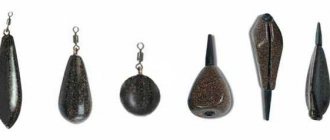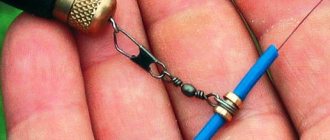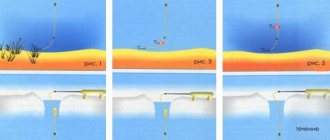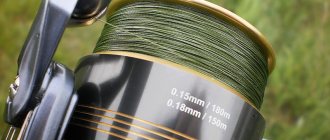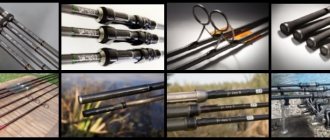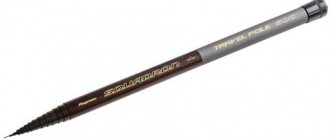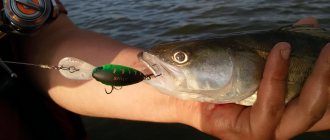A float for long casting makes it possible to fish at a considerable distance from the shore using appropriate fishing rods. Such fishing rods are used in cases where it is not possible to feed fish close to the shore, or it is located at a distance inaccessible for casting with standard tackle.
Long casting is also used when catching large species of fish, when a slow and smooth release of the line is required. The equipment used for long-distance casting consists of: a leash with a hook, a stopper, a weight, the main line, a reel, a float and a rod. The float for such a fishing rod can be sliding or fixed.
Features of the float for long casting
The casting distance and fishing efficiency are affected by the weight of the rod and its accessories. In this regard, floats designed for long-distance casting have significant differences from standard models. As a rule, they are long, which can reach 40 cm. This length allows the fisherman to see the movements of the float from the shore.
Externally, the float looks like a thin torpedo or arrow .
This appearance allows it to remain unnoticed by fish. Although at great depths this is not so necessary, since the fish there are less shy of foreign objects. The torpedo-shaped shape allows the float to align itself during flight and enter the water at the correct angle. Casting with its help is possible to a length of up to 80 meters.
Float mount
The float is attached to the fishing line at one or several points. The difference lies in the specific requirements for the selected tackle, since the nature of the attachment radically changes its behavior when fishing.
- Single point fastening. It is the most popular mounting method, which makes it possible to maintain a high level of sensitivity of the float. This model easily changes its position, easily deviating to the sides. This fastening makes working with it easier, it is easier to remove it from the water, and the risk of the float getting tangled in thickets is reduced.
- Two-point fastening. More reliable when fishing is a float, which is attached to the fishing line at two points. It maintains a stationary working position both during casting and splashdown, and when retrieving and playing with the nozzle. The placement of the float on the fishing line can be deaf and sliding.
- A fixed mount does not mean that it is immovable. The float can be moved along the line, setting the required hook depth. This type of movement is achieved by moving stoppers or beads that restrain its movement. This is the most popular way to place a float.
- The sliding mount allows the float to move freely along the fishing line. Often this movement is limited by stoppers, which are installed in the required positions before fishing. It is used much less frequently than others, mainly on long-casting rods.
Adjusting the fishing float. The sinker must be very heavy in order to quickly deliver the bait to the required place and set the correct position of the float with its weight. It is immersed in water up to the waterline. It should be very small and extremely inconspicuous so as not to scare away the fish with its size and weight.
Gallery: sliding float for long casting (25 photos)
Characteristics of a sliding float for long casting
The sliding float looks like a ballistic missile combined with an arrow. The arrow-shaped section of the float can reach 200-500 mm in length, and its thickened segment - 20-100 mm . A fixed float can have a lifting capacity of about 3 grams and is equipped with a long keel made of metal or plastic and a thick antenna. Sliding floats have a thinner antenna and usually have a lower carrying capacity.
In equipment with a sliding float, the fishing line must be submerged. For fishing with such a float, a standing or low-current reservoir is suitable. A plug rod with 10-16 rings and light equipment for better casting are used. A reel holder with rings that slide along the handle is a better choice. Reels are suitable for sports ones with a minimum number of bearings, so as not to make the structure heavier. The thickness of the fishing line should be 0.08-0.18 mm , and the length should be 60-80 meters.
We also recommend reading:
Budget spinning reels Riobi Exiya Features of crucian carp killer gear and how to make such equipment Diagram of how to learn how to tie a hook to a fishing line Features of fishing with a retractable leash, selection of gear and installation
A tackle with a sliding float must have stoppers consisting of three elements: a sliding bead, a stopper assembly and a lower stopper pellet. A stopper at the bottom prevents sliding towards the main load. A stop bead fixed in front of the float element prevents the unit from getting into the keel cavity. After the bead, a locking knot with a 2 cm mustache is knitted from the thread.
Gear assembly
Now, in order to assemble all the gear together, you need to wind the main fishing line (0.12 mm) onto the spool and gradually thread one end of it through all the guide rings. Next, we attach a shock leader (0.18 mm) to it. The correct size of a piece of fishing line for this element of equipment is 2 lengths of the fishing rod used and about 5-6 more turns of fishing line on the spool.
The sliding part of the float is threaded through the end of the shock leader line. In this case, the carabiner is fixed with a piece of silicone tube. Having secured the upper swivel to one of the ends of the shock leader line, you need to carefully unwind the assembled part of the equipment from the reel.
Stopper knots
The final stage of assembling the tackle is tying the stop knots and then attaching the float. It is important to take into account that the fishing line for the stop knot must have the same diameter as the one to which it will be attached. Fastening knots of this type limits the movement of the float along the fishing line, and makes it possible to fix it at a certain depth.
The optimal number of knots is 2. One is not tightened too much, since it is responsible for lowering the float and moving it, but it must withstand more than one throw with the rod. And immediately after the fisherman finds the depth he needs, the first knot is overlapped by the second, the last one must be tightened tightly.
It is important to leave the ends of the fishing line at the knot at least 2 cm in size. If they are shorter, the fishing line will not be able to lie normally and will begin to tangle. In this case, you can use a sinker as a depth gauge. Therefore, it needs to be removed, while the cambrics are moved closer to the leash swivel, then put on and fixed again. Having set the approximate depth with a knot, you can try casting. And if the float antenna begins to be visible above the water surface, you can continue to adjust the equipment in search of the desired depth.
We recommend reading: Basic rules for choosing braid for spinning rods
But if the float is visible from the surface of the water with its entire working body, this is a guarantee that the olive has touched the bottom.
Fishing equipment with a sliding float
For comfortable and productive fishing, you need to prepare the right gear.
Selection of sinkers
Fishing with one sinker is only possible in calm water. For bodies of water with current, it is necessary to use several weights arranged to reduce weight. The main sinker, located at the very top, plays the role of a lower stopper and must be well attached to the fishing line. It is recommended to place a rubber or silicone tube on top of the main weight to cushion the float.
Selection of fishing line
The thickness of the chosen fishing line increases depending on the type of fish and the casting distance, but the base should always be thicker than the leader. The fishing line is threaded through a wire eye or passed through the body of the float through a special channel. For strong currents, it is better to choose a load-resistant float with a channel. For match fishing, a fishing line with a diameter of 0.18 to 0.20 mm is used.
Selection of swivels
The main function of the swivel is to prevent the line from twisting .
It is important when fishing using a spinner or spinning rod. Twisting of the fishing line occurs due to the rapid rotation of the spinner, which reduces its strength by up to 70%, and periodic winding on the spool. The swivel helps maintain the strength of the fishing line and prevents it from twisting. Carabiners with special clasps also simplify the process of changing bait.
Preparation for installation: necessary equipment elements
Sinker
When using a fixed float, the entire weight of the load is collected in the float and closer to it. When attaching sliding elements of equipment with a load weight of more than 4 g, their location moves as close as possible to the leash.
With this loading method, the fisherman receives several advantages:
- during casting, this type of fastening allows you to easily overcome wind resistance;
- the large weight of the load makes it possible to quite quickly lower the hook with the appropriate bait to the depth or bottom area of the reservoir;
- diving the gear to depth increases the chances of catching a hefty fish trophy.
To properly load the float, you will need sinkers or, as fishermen are accustomed to calling them, “olives” weighing 3.5-8 g. And in order to be prepared for any changes in weather conditions, the right decision would be to make several options for equipment of different weights at once.
When choosing a sinker, it is better to choose a removable type, which has a rod in the center, using the ends of which and two sections of silicone tube to attach the olive to the fishing line. In addition to sinkers, it is worth stocking up on several clamp-type pellets. With their help, the sinker will be attached.
fishing line
The fishing line should be taken with a diameter of 0.12 mm. Of course, you can take a thicker one, but in this case the casting range and accuracy will suffer. Using a sliding type of installation, the load from the main fishing line is evenly distributed over all parts of the tackle.
Recommended reading: How to catch crayfish using crayfish traps
You can’t do without a mounting line, although it in no way affects the operation of the gear, but it must have increased strength. Its diameter should be in the range of 0.14-0.18 mm, it directly depends on the weight of the sinker.
You will also need a soft line for the leash. The optimal diameter is 0.1-0.12 mm. An excellent option would be a specialized fishing line that can withstand extreme breaking loads.
It must be remembered that, without the skills, thin fishing lines for installation will cause constant tangling of the gear. At the same time, their use will not last long as they cannot withstand long-term loads with frequent casting. And they often become the main cause of gear breakage.
Shock leader
The shock leader performs a protective function, preventing damage and breakage of the gear. Therefore, the fishing line used to make it must be very strong.
The shock leader takes on the maximum load, both when casting and when retrieving large fish. Its diameter should be between 0.18 and 0.2 mm. When fishing at short distances, there is no need for it and 0.14-0.2 mm of fishing line is wound onto the reel spool.
Swivels
An integral element of mounting a float for long-distance casting is swivels of sizes from No. 20 to No. 24. They are attached in two places:
- between the mounting line and the leash;
- at the distance between the mounting line and the shock leader.
The use of small swivels gives the fisherman a number of advantages:
- this element is not confused;
- the swivel helps to avoid tangling the leash and the fishing line attached to it;
- does not significantly affect the loading as a whole.
Sliding elements
Other equally important sliding elements of installation include a snap hook with a Teflon or ceramic ring, which allows sliding along the fishing line.
If you have a standard carabiner with a swivel in your arsenal, then they will also work. But in this case, a damper (bead) is attached in front of the locking knot so that the knot does not slip through the eye of the swivel.
You also need to prepare hooks and elastic bands that will secure them. And it is better to reel the ready-made tackle onto pre-prepared reels.
Features of a fishing rod for long casting
For fishing with long casting, fishing rods with a long rod , which can reach 3.6-4.5 m. The fishing rod must be sufficiently rigid, but at the same time have little weight. A fast action is used for this type of rig. The knees of the rod bend closer to the top and maintain rigidity in the rest of the rod. This type of structure helps to maximize the distance of casting the bait.
The rod for long casting has the form of a plug design with three elbows. For compactness during transportation, it is better to choose models with 4-6 parts. The handle is made of cork or rubber with a porous texture.
“Match” reels are ideal for long casting due to their long, lightweight spool and small convex drum. This design allows you to use thinner lines.
The softness and reliability of the product depends on the number of bearings on the reel. But with a large number of them, the weight of the fishing rod also increases, which can lead to rapid hand fatigue. Therefore, it is necessary to choose a product for yourself that will be optimal in terms of smoothness and overall weight.
Amateur fishing allows the use of fishing line with a diameter of 0.12-0.18 mm. For sport fishing, the thickness is reduced to 0.1-0.16 mm. A fishing line 60-80 m long is wound onto a reel with a release of 0.5-2 mm from the edge. If you choose a fishing line with a higher density than water, it will sink well without reacting to the wind.
Factors Affecting Range
In order for a long-casting fishing rod to correctly perform its assigned task, you need to consider the factors that influence casting.
- Rod length. The longer the blank, the longer the distance its tip travels when casting, which means it gives greater initial speed when casting. But when chasing length, you need to understand that different forms are comfortable for people of different heights and physical strength. For example, with a height of 180 centimeters, a rod of 3.90-4.50 meters would be optimal.
- The stiffness or action of the rod. It is believed that parabolic blanks throw light baits a little further than loud, hard whips.
- Line thickness. It is appropriate to say here that thin fishing line experiences less wind load and passes through the rod guides more easily. This provides increased casting distance. But fishing lines that are too thin are rarely used as workers. Basically, their dimensions lie in the range of 0.12-0.18 millimeters.
- Shock leader. In the case of fishing at ultra-long distances, there is a need to use this element of gear. For float fishing rods, its diameter is usually 0.18-0.22 millimeters.
- Float shape. Floats for long-distance casting are shaped more like military projectiles than elements of fishing equipment. They are very long, sometimes reaching forty centimeters, of which about one third is the thickened body, and the remaining length is a strong long antenna.
- Loading equipment. Correctly distributed load allows you to cast the tackle further. For blind installation, the load tends to move towards the float, and for sliding installation, it is closer to the leash. Therefore, often when constructing sliding gear for long-distance casting, an olive sliding along the fishing line is used.
- Coil. All other things being equal, the conical spool on the reel allows you to make longer casts due to the rapid descent of the line.
By taking these nuances into account, you can correctly install a fishing rod for long-distance casting with your own hands.
Features of choosing a float
There is a large selection of sliding floats that have a single attachment point . These floats are suitable for small currents or standing water. The choice of model depends on the behavior and weight of the fish, as well as the fishing depth. The float element with a single attachment point provides a more accurate hookup and makes it easier to spot a bite on the rise. They are more accurate and smooth when casting.
If the current is strong, fishing with a sliding float will be difficult. He will dive, colliding with any debris that the current brings and create a false biting effect.
Secrets of casting technique
Knowing some of the secrets of his technique will help you make a quality cast. Among them:
- Casting a fishing rod with a fixed float must be strong and fast so that the entire load of the jerk falls on the float.
- The classic type of casting is ideal with a sliding float. When the rod is pulled back with smooth movements and when the sinker reaches the top point of the rod, a cast is made.
- To ensure that the equipment does not get tangled and lies flat on the water surface, before it reaches the water, you need to slow down the line from the spool.
- A float equipped with a stabilizer will ensure the accuracy of the throw and help determine the bite on the rise. Its effectiveness is especially noticeable in the scorching sun and reflections of water.
- You can quickly bring the tackle into working position if, after throwing, you immerse the tip in the water and, after reeling in the fishing line, sharply pull it out of the water.
- The load will be distributed evenly over the entire rod if the equipment is immersed in water immediately before casting. At the same time, you need to make sure that there are no tangles or knots on the fishing line. Next, the float is brought to the upper passage ring, the rod is smoothly retracted back and a soft cast is performed.
And in order to avoid confusion and breakage of equipment parts during transportation, they must be correctly positioned and packaged.
A good solution would be to buy a specialized case where you can compactly place the reel separately from the spool. A more economical option would be to use a reel.
Proper installation of the sliding rod rig for long casting will speed up the process of recognizing the features of the bottom of the reservoir, and significantly increase the chances of catching a decent fish trophy.
Installation of a fishing rod for long casting with a sliding float
Proper collection of float gear for long casting directly contributes to successful fishing. Sinkers are the most important element of fishing rod equipment. For sliding equipment, they are located at a close distance from the leash , and for fixed equipment, closer to the float. The role of sinkers is played by pellets of different shapes. They are selected according to the type of float. The weight of the sinker is related to the diameter of the fishing line.
Sinkers are distributed by weight. Heavier olive-like elements are fixed on top, and smaller pellets below. Heavy weights attract the equipment to the bottom, and small ones stabilize the leader and hooks.
Using carabiners, the leash is attached to the fishing line. The use of protective clips that secure the hook with the bait will prevent the line from tangling when casting.
A cross-lock fastener is attached to the end of a 75 cm long fishing line . A clip is attached above it for protection, then a bead is put on. Next, without clamping, a crimp sleeve is installed and another bead is placed on top. The line goes into the eye of the swivel and is passed through the last bead. An additional swivel is attached to the free end of the fishing line. A leash with an existing hook 60 cm long is attached to the remaining eye on the first swivel.
Casting technique
The technology of fishing with a fishing rod for long casting is similar to using a spinning rod. For a successful throw without overlapping tackle, the weight of the sinkers should be 25%, and the rest of the weight should be on the float.
Before casting, the float should be at a distance of 1-1.5 m from the top of the fishing rod. There should be no objects around that interfere with the swing and flight of the tackle. Before the hook with a load falls into the water, the fishing line is slowed down with your fingers, and the equipment rushes forward.
After the float touches the water, the bow on the spool closes and the line is submerged by the end of the rod. Then the bow can be opened again and the line released. The float element rests against the stopper after standing on the water.
After casting, the rod is placed on a stand with the top as close as possible to the water. The tension of the fishing line will provide high sensitivity when biting.
Casting technique is perfected over time. For successful fishing, it is important to properly prepare your gear. You can build a sliding float with your own hands; you don’t have to spend a lot of money on expensive equipment.
